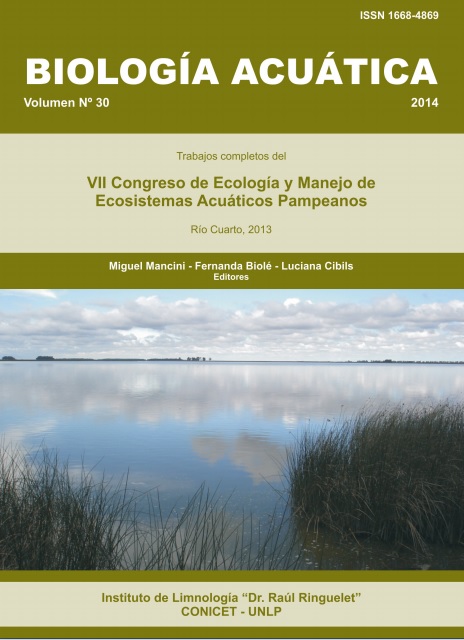El bentos y su fracción derivante: Composición y estructura en un arroyo regulado (Achiras, Córdoba)
Keywords:
benthic community structure, drift, regulated stream, functional feeding groups, ArgentinaAbstract
Flow regulation modifies the physico-chemical conditions of the fluvial system and consequently its biota. The aim of this study was to analyze the composition and structure of benthic and drift, upstream and downstream of the Achiras dam before and after construction. Sampling of benthos (Surber nets, 0.09 m2 and 300 μ) and drift (nets 1 m long, 300 μ and 0.0192 m2) were performed in high water and low water periods. The organisms were identified to the lowest possible taxonomic level and benthic Feeding Functional Groups were identified. Density, taxonomic richness, Shannon diversity and evenness for benthos and drift were calculated. Data were compared by three-way ANOVAs. The structure of both assemblages varied spatially and temporally. Benthic community showed a total of 110 taxa, corresponding to 8 phyla, while drift assemblage 55 taxa corresponding to 6 phyla. In both assemblages, the phylum Arthropoda was the most abundant. In the site below the dam and in the post- construction period, the benthos richness was greater, while drift evenness exhibited the highest value at the site below the dam during low water period. The filtering collectors and scrapers showed significant differences between year, site and hydrological period. The chironomids Tanytarsus sp. and Rheotanytarsus sp. were the most abundant among collectors while filtering Camelobaetidius penai and
Stenophysa sp. among the scrapers. Data obtained in this study show that both data of benthic structure and its drifting fraction as the GFA data would indicate no significant changes attributable to dam effect. Longer studies would be required since in regulated systems most ecological changes happen more slowly than observed immediately.





















